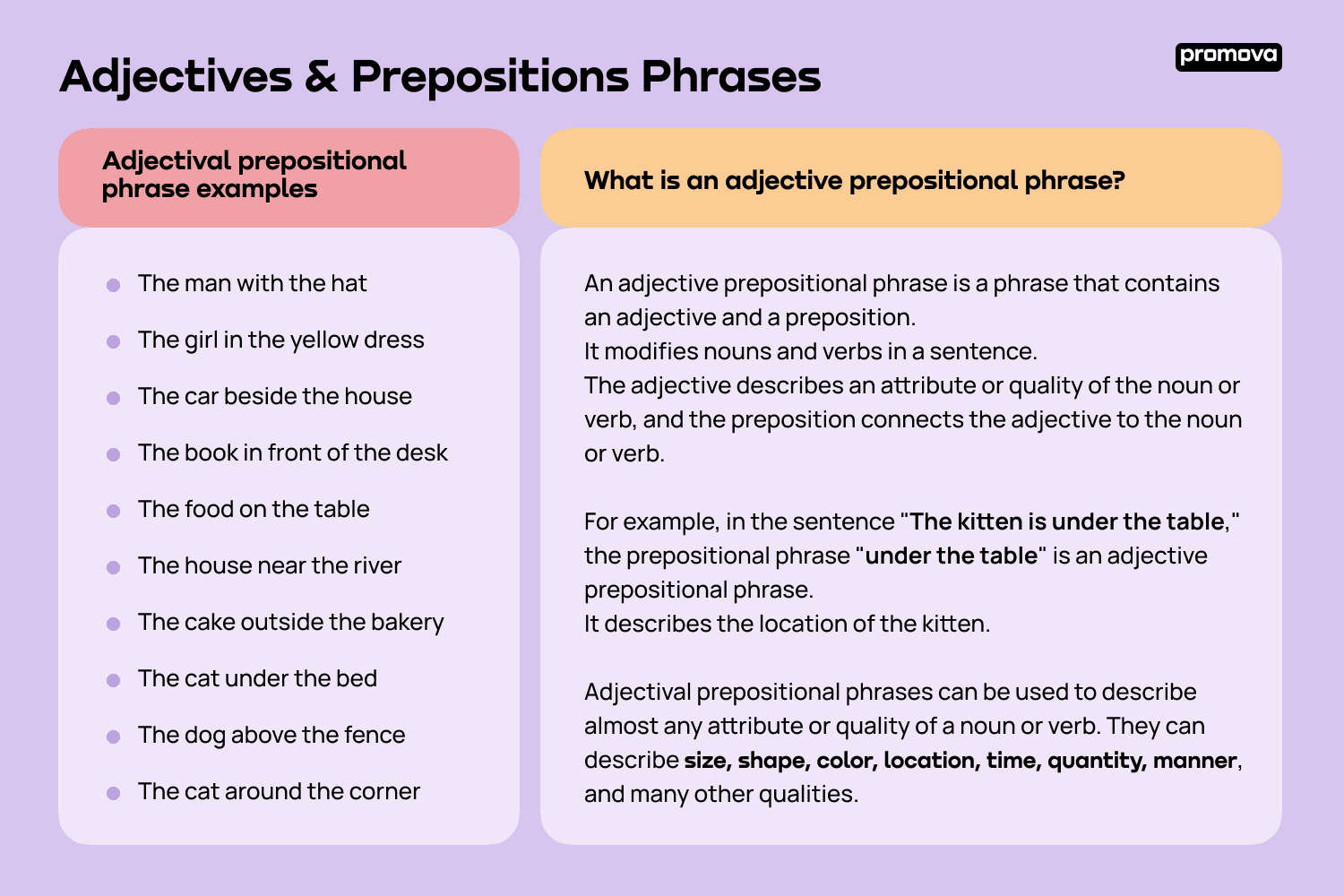Adjectives & Prepositions Phrases
Contents
Adjectival prepositional phrases are among the more complex structures in English grammar but are quite useful and important. In this article, we'll discuss what an adjective preposition phrase is, look at some examples, and discuss how to recognize them.
What is an adjective prepositional phrase?
An adjective prepositional phrase is a phrase that follows and describes a noun or pronoun; such phrase functions as an adjective. It modifies nouns in a sentence. The adjective describes an attribute or quality of the noun, while the preposition within the prepositional phrase connects the noun to another element in the sentence. For example, in the sentence "The book on the table belongs to me," the prepositional phrase "on the table" is an adjective prepositional phrase that modifies "the book."
Adjectival prepositional phrases can be used to describe almost any attribute or quality of a noun. They can describe size, shape, color, location, time, quantity, manner, and many other qualities.

Adjectival prepositional phrase examples
Here are some examples of adjectival prepositional phrases:
- The man with the hat
- The girl in the yellow dress
- The car beside the house
- The book in front of the desk
- The food on the table
- The house near the river
- The cake outside the bakery
- The cat under the bed
- The dog above the fence
- The cat around the corner
As you can see, these phrases can be used to describe almost any attribute or quality of a noun.
In addition, more than one phrase can modify the same noun. For example, the sentence "The man with the hat and the red scarf" contains two adjectival prepositional phrases. Here are 5 more complex sentence examples:
- The noise coming from the old factory was loud and unpleasant.
- The flowers in the garden were colorful and fragrant.
- The children playing in the park were happy and energetic.
- The house on the hill had a beautiful view of the city.
- The cat under the bed was scared and hiding.
2
How do I recognize an adjective preposition phrase?
Recognizing an adjectival prepositional phrase can be tricky, but some tips can help. First, look for the obvious - combinations of adjectives and prepositions. The preposition will often be followed by a noun or pronoun, while the adjective will come earlier.
Another way to recognize an adjectival prepositional phrase is to look for a phrase that modifies a noun. If the phrase describes an attribute or quality of the noun, it's likely an adjectival prepositional phrase.
Finally, pay attention to punctuation. Adjectival prepositional phrases are usually set off with commas. This isn't always the case, but it's a good rule of thumb. If a phrase is set off with commas, it's likely an adjectival prepositional phrase.
Sometimes, a phrase can work as both an adjective prepositional phrase and an adverbial prepositional phrase. In this case, the context of the sentence should help clarify which type of phrase it is. So, if a phrase modifies a verb, it's more likely to be an adverbial prepositional phrase.
Here is an example:
"The cat, with its nimble paws, jumped onto the table."
In this sentence, "with its nimble paws" is an adjectival prepositional phrase that modifies the noun "cat." However, it could also be an adverbial prepositional phrase that modifies the verb "jumped" if we change the sentence to "the cat jumped, with its nimble paws, onto the table."
Summary
Adjectival prepositional phrases are one of the more complex structures in English grammar, but they are still quite useful. You can use adjectival prepositional phrases to describe almost any attribute or quality of a noun, and they can be recognized by looking for an adjective followed by a preposition and a noun or pronoun or by looking for a phrase that modifies a noun.
With a bit of practice, you'll soon be able to recognize and use adjectival prepositional phrases with ease and use them in your day-to-day conversations.



Comments